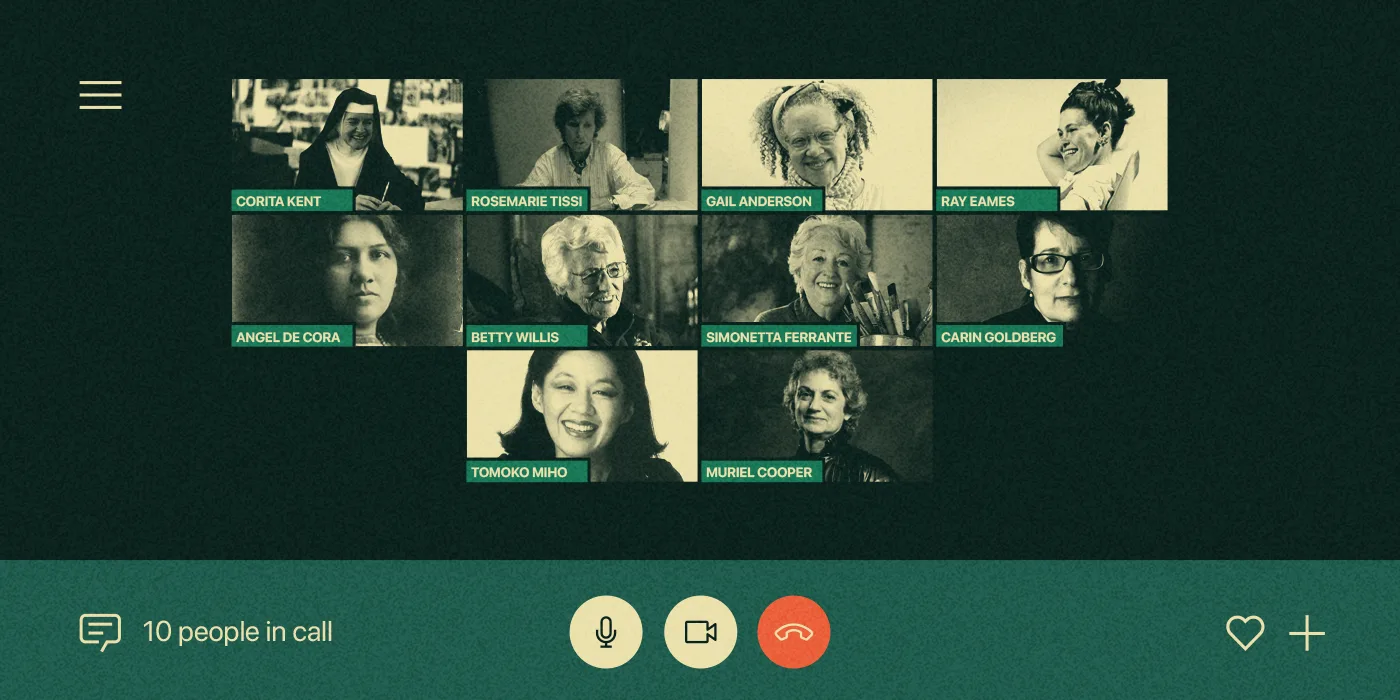Dear Amigos,
Today we celebrate International Women’s Day, and as designers, we’ve experienced the real-time erasure of the impact of women’s achievements and legacy in the design industry. From schools to our day-to-day lives, it’s rare to hear discussions about the many female faces that paved the way in our field. That’s why, in a sea of admirable women, we bring you 10 names as proof that women designers deserve more recognition.
Corita Kent

Corita Kent (born Elizabeth Kent in 1918) was an American artist and educator who found her way to become a social justice activist: through art. She became a nun at only 18 years old, entering the Sisters of the Immaculate Heart, a community where she was able to study art and later become a teacher herself, having future promises in attendance such as Saul Bass, Alfred Hitchcock, and John Cage.
She was heavily inspired by Pop Art, mixing pop culture and advertisement images, bright colors, and expressive typography and calligraphy with political and religious messages, advocating for peace and justice.

1. American Sampler, 1969. 2. Jesus never fails, 1966
She left the Immaculate Heart College in 1968 and moved to Boston, where she kept creating art until her death in 1986. Her work lives in many world-known art museums, such as the Whitney Museum of American Art, the Museum of Fine Arts, Boston, and the Metropolitan Museum of Art.
Corita’s compromise with using art as a medium for social change makes her legacy incredibly relevant. You can learn more about her work through the Corita Art Center website.
Rosemarie Tissi

Rosemarie Tissi (born in 1937) is a Swiss graphic designer known for her post-modern approach to typography and poster design.
She studied graphic design at the School of Applied Art in Zurich. As a student, she did her apprenticeship with Sigi Odermatt, who offered the challenging and out-of-the-industry kind of creative work she was looking for. After their success as a team, they decided to create their design agency, Odermatt+Tissi.

1. Merce Cunningham Dance Company, 1991. 2. Photocomposition – Offset, 1982. 3. Thaynger Herbstschau Poster, 1956.
Her work is defined by the clever use of geometry to simulate movement, breaking and following the grid, as well as minimalism, simple patterns, experimental layouts, and typography. Tissi has been awarded the gold medal from the Art Directors Club of New York and the Jan Tschichold award from the Swiss Culture Awards.
Her legacy continues through her teaching, inspiring many designers in Switzerland and the rest of the world, maintaining her as an unforgettable figure in the graphic design world.
Gail Anderson

Gail Anderson was born in the Bronx, New York in 1962. She studied graphic design at the School of Visual Arts (SVA) in New York City, where she was taught by one of her mentors and biggest inspirations, Paula Scher.
She worked in the editorial industry before beginning a 15-year career at Rolling Stone Magazine, where she became senior art director until 2002. She also worked as a creative director in SpotCo before associating with Joe Newton and creating their studio, Anderson Newton Design.

1. Emancipation Proclamation postal stamp, 2013. 2. Exhibition Poster, 2014. 3. Type tells tales, 2017. Image credit: gailycurl.com
One of her notable passions is typography, refining her technique and never shying away from non-traditional methods, like wood and various objects, to create new typographic experiences. Her type work has expanded through many industries, including Broadway theater and many publications in the entertainment industry.
Gail has been granted many awards from the Type Directors Club, AIGA. Art Directors Club and many other prestigious design organizations. In 2013, she was commissioned by the US Postal Service to create a commemorative postage stamp for the 150 years since the Emancipation Proclamation. Continuing her career as a chair director for the Advertising and Design departments at the School of Visual Arts and distinguished writer and art director, Gail is a huge representative of African-American influence in the current graphic design field. You can visit her website here.
Ray Eames

Ray was an American artist, designer, and architect who extended her talent to many different mediums. She was born in 1912 in Sacramento, California. In the 40s she started her art studies at the Cranbrook Art Academy, where she met Charles Eames, who was in charge of the industrial department. After discovering they shared their passion for design, they married in 1941 and moved to Los Ángeles, where they started working as a design team.

1. Eames Lounge Chair & Ottoman, 1956. 2. Eames House, 1949.
Ray and Charles’s motive was to mix design and ergonomics through furniture production, carefully selecting their materials to increase access without compromising aesthetics. They released more than 40 designs to the American market, which included the Wire Mesh Chair, the Long Chair and Ottoman, and the Aluminium Group series. They also built and designed their own home in 1949.
Ray died in Los Angeles in 1988. She was able to defy a society that reduced women to submissive wives through her expansive talent and thoughtful designs, paving the way for generations to come.
Angel De Cora

Born in 1871 in the Winnebago Reservation, Nebraska, Angel De Cora was a native american painter, designer, and illustrator, a member of the Ho-Chunk (Winnebago) tribe.
She attended the Drexel Institute of Art, Science and Industry and the Cowles Art School, as well as the Museum of Fine Arts In Boston. As a student, she impressed teachers and colleagues through the identity she expressed in her work, which led her to realize how little representation of Native American culture was present in the artistic world.

1. Yellow Star, 1911. 2. “The Indians” Book, 1907.
Later, as a teacher at the Carlisle Indian Industrial School, she made big efforts to preserve the tribal heritage by motivating her students to research and incorporate Native designs in their artistic work.
Angel De Cora died in 1919. She became one of the most known Native designers and used her influence to advocate for the recognition and praise of Native expression as a huge contribution to the history of American art.
Betty Willis

Betty Willis was born in Overton, Nevada in 1923 and became internationally known for designing the famous “Welcome to Fabulous Las Vegas” sign.
She moved to Las Vegas in her childhood and left to Los Angeles to study art. Back in Las Vegas, she worked as a commercial artist at YESCO and soon after became part of the team at Western Neon, thats when she started exploring her interest in neon sign design, a growing industry in the city back in the late 50s.

1. Welcome to Fabulous Las Vegas sign, 1959. 2. The Mint sign, 1957.
Betty did signs for many hotels and bars in the area, but when she was approached by Sig Rogich to design the welcoming sign for Las Vegas, she couldn’t imagine the impact that the unusual shapes and flashy lights would make in the signage world. Besides, she stood out in a man-dominated business.
Betty never trademarked the sign, for her it was a gift to the city. She continued to work until her 70s and was celebrated and loved by many visitors and locals from Las Vegas until her passing in 2015.
Simonetta Ferrante

Born in 1930 in Milano, Italy, Simonetta comes from a musical studies background, obtaining her piano diploma in 1953. However, one artistic medium was not enough for her, and that’s why she went to the Central School for Arts and Crafts in London to obtain another diploma in Graphic Design, Painting, and Drawing.
Back in Italy, she focused on her graphic design career, working alongside people like Bob Noorda and Bruno Munari and participating in a generation of talent that developed Milano’s design industry as we know it today.

1 & 2. Map of Milan, 1970 3. Advertisement poster, 1950s
She opened her design studio in 1971, collaborating with colleagues Giovanna Graf and Carlo Pollastrini. Some of their clients were Esselunga, Mondadori, and Galgano.
In 1994 she closed her studio to fully dedicate herself to painting and calligraphy, two of her biggest passions, participating in many galleries across Italy and the world.
Carin Goldberg

Carin Goldberg was an American designer and art director born in 1953 in New York. She studied fine arts at the Cooper Union in Manhattan and soon after started her design career by working for CBS, first in the television department and later transferring to CBS Records, where she was able to create iconic album covers for artists like David Bowie, The Clash, and Blondie.

1. Madonna album cover, 1983. 2. Punc’t poster series, 2004.
She opened her studio in 1982, where she continued to work for clients in the music and editorial fields. One of her most known works was the cover for Madonna’s debut album. She was known for her experimentation with expressive typography and shapes, as well as her testing of historical and aesthetic connections, such as the reissue of Ulysses by James Joyce where she found inspiration in modernist design.
Carin was also a remarkable teacher at the School of Visual Arts in New York, recognized through the Art Directors Club Grandmasters Award for Excellence in Education, as well as the 2009 AIGA medal. She passed recently, in January 2023. Her restless inventive nature will surely inspire many designers and ensure her legacy for generations.
Tomoko Miho

Born in 1931 in Los Angeles, California, Tomoko Miho was a Japanese-American graphic designer known for transforming layouts through her management of space and composition.
Tomoko started her design education through a summer scholarship at the Minneapolis School of Art, later attending the Art Center School in Los Angeles with a full scholarship on industrial design. She had the chance to travel to Europe and find inspiration in the Swiss design industry and unveiled her mission “to join space and substance” through graphic design.
She worked with John Massey at the Center for Advanced Research in Design (CARD) where they developed design and communication projects for clients like the Atlantic Richfield Company, Herman Miller Inc., and the Container Corporation of America.

1. Wall Street, 1968. 2. Pioneers of Flight, 1976. 3. 65 Bridges to New York, 1968.
In the 1980s, Tomoko opened her own studio, Tomoko Miko & Co., where she got involved with the MoMa, the Smithsonian Institution, and the National Air and Space Museum. During this time she got to scout her expression through architecture-inspired poster design work for cities like New York and Chicago. Miho was awarded the 1993 AIGA medal, and her work continues to be a huge part of graphic design history years after her passing in 2012.
Her legacy stands out for the clever and intentional use of space and information, inspired by Swiss design and Shakkei, a traditional Japanese garden design discipline that explores the integration of foreground and background.
Muriel Cooper

Born in Brookline, Massachusetts in 1925, Muriel Cooper was an influential digital and editorial designer, especially covering the connection between design and tech.
She studied art at Ohio University as well as the Massachusetts College of Art in 1952. She found many inspiring work opportunities after graduation, such as working with Paul Rand in New York and opening her own design studio.

1. MIT Media Lab, 1990. 2. Computer Generated Type, 1980’s.
One of the defining turns in her career was her involvement in the growing tech industry by taking over as the Design Director at the MIT Press in 1967. There she birthed many transcending pieces in graphic design history, such as the MIT Press logo, “The Bauhaus” (1969), and “Learning from Las Vegas” (1972). She became a founding member of the MIT Media Lab, where she began tracing the starting points of software interface design.
Muriel wasn’t able to see the impact that computers and digital media would have in our lives after her passing in 1994, but her legacy and experimentation with design and new technologies shaped our experiences, even if many don’t know her name.
We hope you leave this article not only with a few new names learned but with a curiosity to investigate women in design, as well as women in your own life. Take your time to cherish them, share their stories and say their names, make sure their legacy is never looked upon. Happy International Women’s Day amigos!
Yours truly,
Since you are really into design, you might be interested in these other articles and resources:



